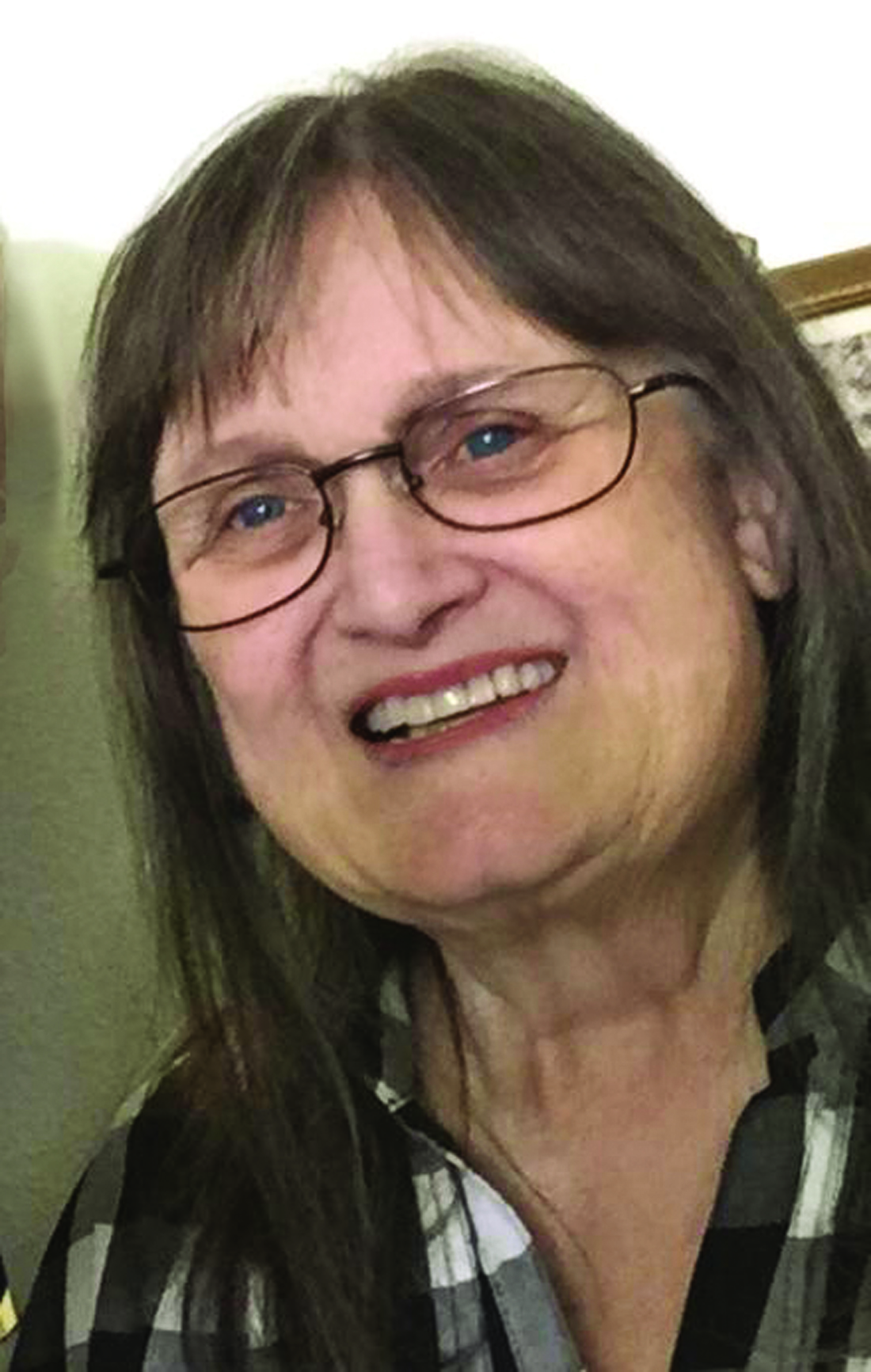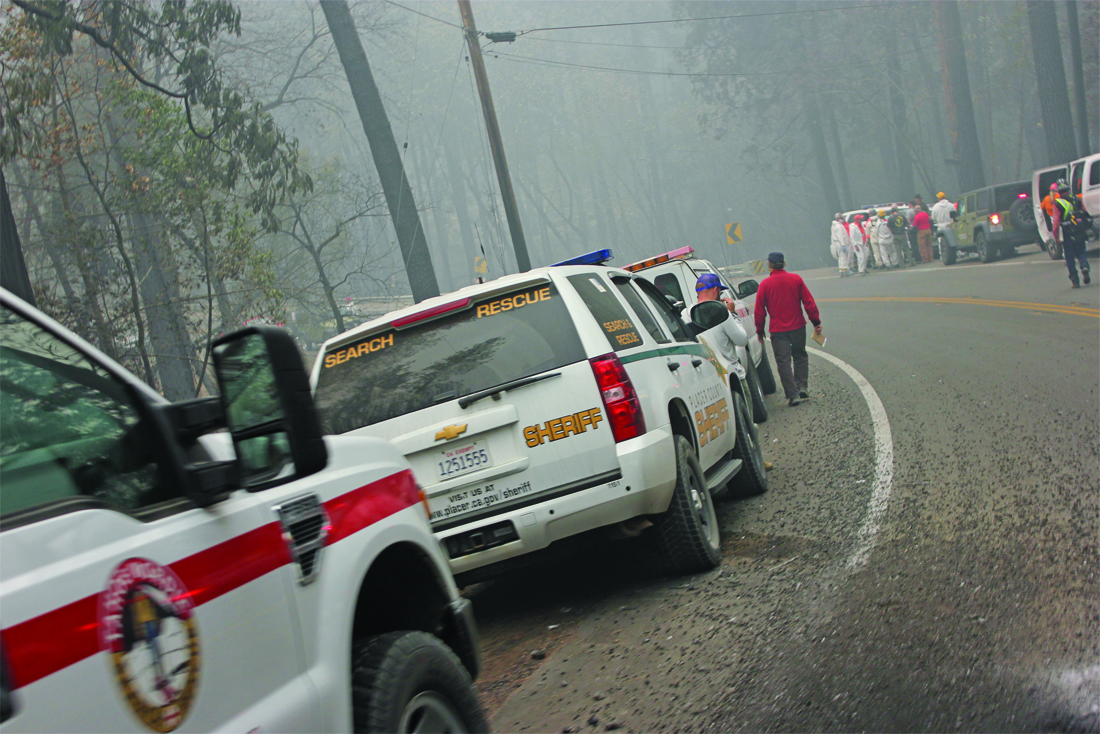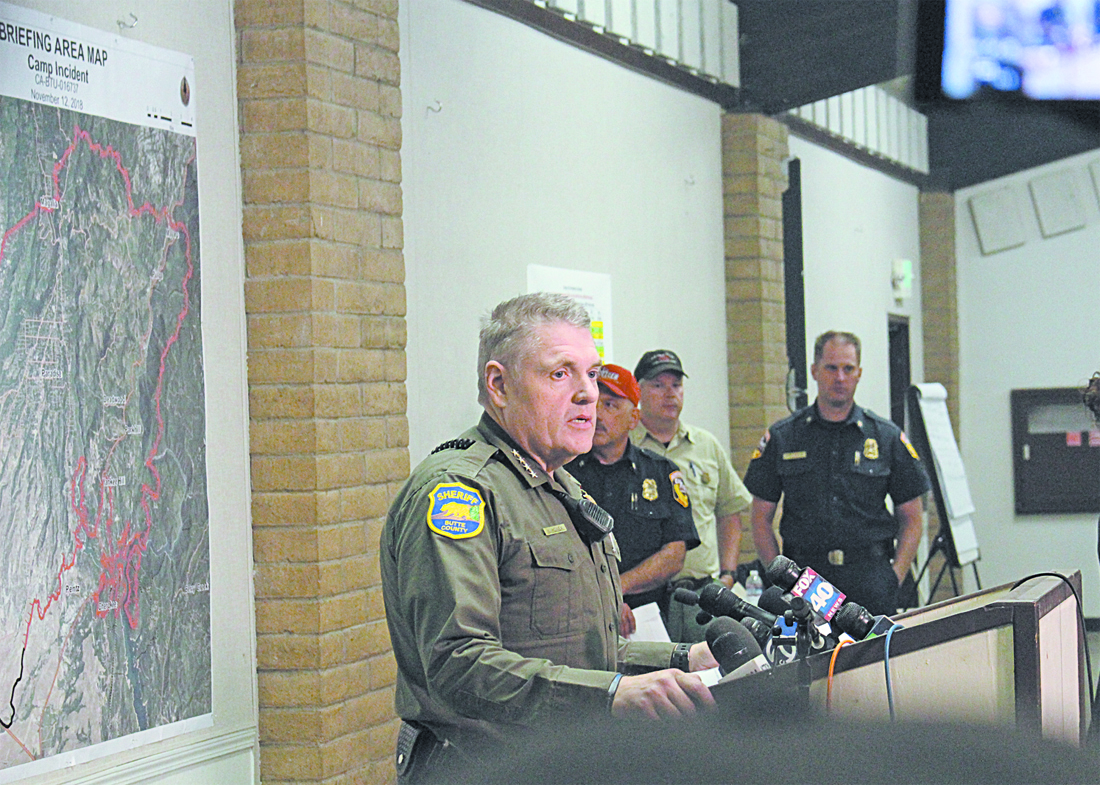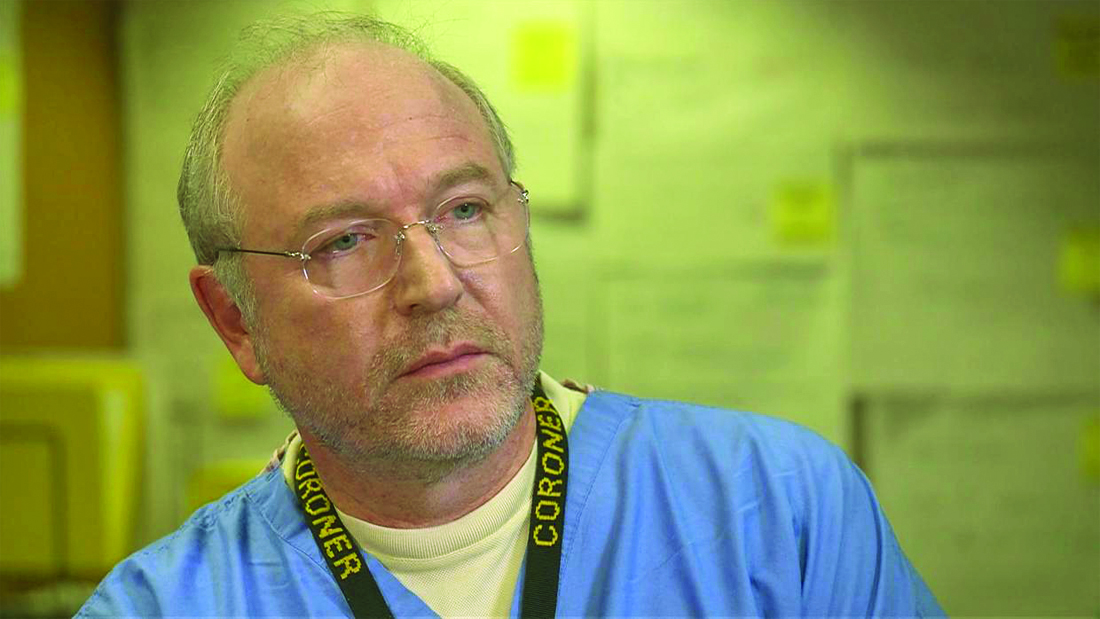
PHOTO by Andre Byik
Wally Sipher holds a photograph of his sister, Judy, at the site of her Paradise apartment off Clark Road.
As the Camp Fire barreled toward the town of Paradise, Wally Sipher called his sister, Judy, from his home in nearby Chico. They spoke at about 8:30 a.m. A massive plume of smoke could be seen from the valley floor. Sipher told her the situation looked scary and she ought to get out. She didn't seem worried.
That was the last time they spoke.
Judy, 68, lived in an apartment surrounded by tall pines at Paradise Community Village off Clark Road. It was an attractive low-income housing complex, Sipher recalled, and she was fortunate to have landed a spot there. Judy arrived in Paradise in 2008 after retiring from her job at a company in Santa Rosa that manufactures computer parts. She enjoyed the solitude of the foothills and moved there to live closer to her parents, who’ve since died. Over the years, Judy had rekindled a relationship with her brother in Chico, too.
Human remains, Sipher said, were found in or near the bathroom of Judy’s bottom-floor apartment, which was leveled by the blaze. He believes she likely sought shelter there in her final moments.
It’s been nearly nine months since the state’s deadliest and most destructive wildfire ripped through eastern Butte County—charring Paradise, Magalia and the smaller communities of Butte Creek Canyon and Concow and killing at least 85 people. But closure remains elusive for Sipher. Judy, he said, has yet to be confirmed dead by the Butte County Sheriff’s Office. Her case is believed to be among the six whose remains have not been positively identified.
What’s complicated the identification process in some cases, authorities tell the CN&R, is that the remains are so badly degraded from the intensity of the fire that DNA analysis is difficult to conduct. In others, authorities have few or no clues as to who the deceased could be.
The wait for official word from the Sheriff’s Office has been frustrating, Sipher said, and the communication about the hold-up lacking.
“If they’re having difficulty, OK, let us know you’re having difficulty,” he said.
Kory Honea, sheriff and coroner for Butte County, received grim news in the evening hours of Nov. 8. The Camp Fire had been burning for less than a day, but the scope of the immediate destruction was beginning to take shape. Honea told the CN&R he was at a command post set up at the Silver Dollar Fairgrounds in Chico when sheriff’s officials learned multiple people had been found dead in cars on Edgewood Lane in south Paradise. They’d died trying to escape the inferno and were among the first human remains recovered.
In conversations Honea had that day with state and federal officials, he was told to expect more deaths. Many more.
“Based on the number of people in the area, based on the geography, based upon how rapidly this moved, they said, ‘Sheriff, you should expect somewhere between three- and four-hundred deceased persons,’” Honea said. “And I’ll tell you that that number was startling. And I thought to myself, Well, I’m not going to start counting bodies until we actually have recovered them.”
In the following days and weeks, officials mounted an unprecedented search and recovery operation. They scoured a fire zone that measured about 240 square miles—a land area about as expansive as the city of Chicago—and included about 18,000 places, such as burned homes, businesses, outbuildings and other areas where people may have sought refuge from the flames. An estimated 10,000 people contributed to the search, including firefighters, coroner’s investigators, forensic anthropologists, crime analysts, morgue workers and DNA specialists.
“What we ended up with was, in my view, probably one of the most complex mass casualty events that anyone has ever had to deal with,” the sheriff said, adding, “Perhaps maybe other countries that have been war-torn, or things of that nature, but from a … civilian public safety aspect, I’m not entirely sure that they have.”
In other mass-casualty events in which there could be a similar or greater number of deaths, such as a commercial plane crash or terrorist attack, the search area typically is limited. Searchers also may have a better understanding of whom they are looking for, taking into account such things as passenger manifests and corporate rosters. And the remains would be expected to be more intact than what was left behind in the Camp Fire.

Photo courtesy of Wally Sipher
Portrait of Judy Sipher.
In some cases, Honea said, remains recovered in the fire zone were “just mere fragments of bone.”
Jennifer Celentano, an investigative assistant at the Sheriff’s Office assigned to the Camp Fire, said search teams adapted to their mission under conditions that changed daily. The fire, which wasn’t contained until late November, posed several challenges. Some locations had to be searched multiple times due to the sustained smoldering, for example.
Additionally, a call center set up to report missing people, which search teams used to point them toward possible fatalities, took so many calls the Sheriff’s Office’s computer-aided dispatch system crashed several times. At one point in November, the list of people unaccounted for in the fire grew to more than 1,000 names.
To date, two people remain on the official Camp Fire missing persons list—Wendy Carroll-Krug and Sara Martinez-Fabila. Honea said the women will remain on the list until officials have confirmed their whereabouts. He said the fact that someone is on the list does not necessarily mean that person has died, even nine months after the fire sparked. Nevertheless, the sheriff said his office has remained open to the possibility that more remains could be found in the burn zone.
Celentano said she has been in contact with state officials conducting debris cleanup on the thousands of burned-out lots, and crews have been instructed to look out for potential human remains. As of July 15, about 7,000 parcels had been cleared under the government-sponsored debris-removal program. More than 4,000 parcels await that work.
“Any time any type of bone is found, we’re still researching that and making sure it has nothing to do with the Camp Fire or human remains,” she said. “So, that’s an ongoing thing until the debris is gone.”
Celentano, who graduated from Chico State with a bachelor’s in anthropology, said a “huge piece” in solving the identification puzzle turned out to be Chico State’s anthropology department.
“We wouldn’t have been able to do what we did without anthropologists there telling us what we had and what we didn’t have,” Celentano said, adding, “The remains were just so badly burned it was hard to tell.”
In some cases teams uncovered human remains that had been commingled, meaning they belonged to two or more people, she said. The Sheriff’s Office in February revised the Camp Fire death toll downward from 86 to 85, after learning remains previously believed to belong to two people actually belonged to one.
Most people who perished in the fire died from causes related to the blaze, Honea said. In one case, however, officials say it appears a man took his life, likely believing he would otherwise become trapped and consumed by fire.
The last person to be positively identified was Shirley Haley of Paradise. The Sheriff’s Office released her name on July 10. She was 67. Haley lived with her sister, Barbara Carlson, 71, who also was killed in the blaze, in a mobile home on Heavenly Place. Carlson was positively identified in December.
Carlson’s granddaughter, Maggie Masterson, 23, of Magalia, told the CN&R that not having official confirmation about Haley’s death until July was surreal, as if she was living in a dream and could suddenly receive a phone call from her great aunt or run into her in public.
“The not knowing is what really hurts,” Masterson said, adding that once Haley’s name was released she felt relief, “knowing that we can finally start the grieving process.”
Seventy-nine people have been positively ID’d. Of the six remains pending identification, four have been tentatively identified, meaning investigators have circumstantial evidence pointing to who the people were, such as the location where the remains were found (the residence where the person lived, for example) and/or information provided by family members. The two aformentioned missing women are not among the people in that group, Honea said. Sipher believes his sister is among the people who have been tentatively identified, though Honea wouldn’t confirm that.
For the final two, Honea said, officials have hit roadblocks.

PHOTO BY Melissa Daugherty
Search and rescue teams from across the state deployed to the burn zone searching for human remains in the weeks following the start of the Camp Fire. Pictured here Nov. 14 is a stretch of Pearson Road.
In one case, the severely damaged remains of a man, the sheriff said officials will try to identify him using private genomic data- bases—such as GEDmatch and 23andMe—akin to how the identity of the Golden State Killer was uncovered. The sheriff noted, however, that limitations such ancestry websites place on law enforcement investigations could affect that process.
If those efforts fail to produce clues as to potential relatives of the deceased, the Sheriff’s Office may pursue other avenues to generate leads, such as releasing details regarding when and where the person’s remains were found, Honea said. The sheriff refused to release those details to the CN&R.
He said his team first wants to try to identify the person using genealogical websites before collecting other potential familial DNA samples. Asked why, nine months later, he would not release more details in the case that may help identify the person, Honea said, “At this point, we’re choosing to do this route. I don’t believe it harms the outcome. Based on the recommendations of my team, that’s the approach we’re going to do. That’s the approach we’re going with.”
In the other case, officials recovered a single bone and only recently obtained DNA from it suggesting the remains are human, Honea said, adding that he was not as familiar with the status of that case.
Honea told the CN&R that it could take several months to identify the remaining Camp Fire victims by DNA, which is the preferable method for the Sheriff’s Office because it is conclusive. The remains are among the most damaged and degraded, the sheriff noted. If identification through DNA fails, Honea said they could be identified using circumstantial evidence, something he said has been done in at least one case so far.
“As we get farther and farther down the road, it becomes this analysis of diminishing returns, right?” the sheriff said. “And if we get to the point where it’s going to take three months to determine whether or not we can identify somebody based on DNA—in balancing competing interests—we may have to look to circumstantial evidence to identify those people so that family members can move on with the process, and whatever other interested party is in need of the information can do what they need to do.”
Honea noted official death certification may be needed to settle estate matters and could be pertinent to ongoing litigation, such as wrongful death lawsuits filed against PG&E, which Cal Fire has deemed responsible for the fire.
The majority of the identifications thus far have been made through DNA analysis. In other cases, fingerprints, dental records or photographs sufficed, Celentano said. And in some instances people were identified by “hardware,” such as hip and knee replacements that were matched to medical records, Sacramento County Coroner Kimberly Gin said.
Gin’s office has served an integral role in the Camp Fire identification effort. Butte County does not have a morgue, so remains were stored locally in a makeshift facility set up in a warehouse off Highway 149 between Chico and Oroville. From there, a refrigerated van transported them to Sacramento.
“We called up and said, ‘We need help,’ and they basically opened their entire morgue up to us,” Honea said. “And Kim Gin … has basically worked on our behest the entire time.”
Gin told the CN&R that her office had the capability to properly house the dead. Doctors also were on hand seven days a week for about a month for examinations, including anthropology exams, and DNA testing was conducted on-site. As of early July, Gin said her office, in collaboration with Butte County authorities, completed over 70 identifications. Fifty cases were solved by DNA, with the vast majority completed using a “rapid DNA” system created by the Colorado-based biotechnology company ANDE. The system, which can interpret DNA in about 90 minutes and be used to confirm familial relationships of the deceased, produced a “remarkable outcome,” she said.
“We were able to bring closure to a lot of families using this type of technique,” Gin said. Had officials relied only on the traditional method of DNA analysis, which can take months, many more families would still be waiting for official identification of their relatives, she added.
The nature of the disaster—a massive wildfire that went largely unchecked in its first day—posed challenges unlike other disasters, she noted. Dental and medical offices burned in the blaze, for example, complicating the more traditional routes of identification. Family members of the deceased were at times difficult to locate because of the evacuation of about 50,000 people in the fire zone.
Going forward, the Camp Fire should be studied as a model for identifying victims in mass-casualty events, Gin said. Rapid DNA technology, she said, should be incorporated alongside conventional methods.
“I think that we need to continue and not go backward,” she said, adding that the fire was a “horrible” disaster, but if a similar event happens again, “I would hope that we learned from it and prepare ourselves.”

CN&R file photo
Butte County Sheriff Kory Honea addresses the media in the days after the Camp Fire started.
The use of rapid DNA technology to identify victims in the Camp Fire started with an email Honea received a couple of days after the fire sparked, the sheriff said. The message was from an official at the California Governor’s Office of Emergency Services (Cal OES) who pointed to ANDE.
Richard Selden, chief scientific officer and founder of ANDE, landed in Sacramento about a week later. The conditions were so smoky he couldn’t see the other planes across the tarmac. Selden said Honea had accepted his proposal detailing the approach his team would take to try to identify fire victims.
The plan wasn’t a financial one. ANDE did not charge the county for its services, which Honea, in talks with the company, said totaled between $700,000 and $1 million.
Honea and Gin, the Sacramento County coroner, determined the ANDE team should set up in two locations: the Disaster Recovery Center at the former Sears building in Chico, where family of the deceased could provide information and cheek swabs for DNA reference, and the Sacramento County Coroner’s Office, where remains were being transported.
Selden worked out of Sacramento over the next three weeks. Officials involved in the identification process, he added, agreed that ANDE’s rapid DNA system could play a part in the process but did not immediately believe it would play a starring role.
At first, investigators looked for the “easy” way of making identifications, such as obtaining fingerprints and dental information, Selden said. That was only possible, however, in a small number of cases. “Unfortunately, there were very, very few cases that could be closed based on the easy way,” he said. “In the end, the remains were very badly degraded.”
After consulting with forensic anthropologists and pathologists, Selden said, the ANDE team began analyzing samples of remains using its instrument—also called ANDE—which resembles a large microwave oven. Selden said the rapid DNA technology worked on the first eight samples it processed, and when familial DNA reference samples arrived from Chico, the team began making matches.
The early success was an encouraging development at Gin’s office.
“Little by little, we got more space in that war room,” Selden said, adding that by the end of his three weeks at the Sacramento Coroner’s Office, DNA ruled the identification process.
A Harvard-educated doctor whose focus has been on genetics, Selden founded ANDE about 15 years ago with a goal of conducting rapid clinical diagnostics. He had been pursuing the possible applications of obtaining a quick DNA result when he said he stumbled into forensics.
Selden said he knew nothing about forensic DNA at the time, but he learned that samples obtained from a crime scene could take six to 24 months or longer to be processed and generate a result.
ANDE’s system obtains DNA identification by interpreting what’s been known as “junk DNA,” which, according to the U.S. National Library of Medicine, is noncoding DNA that does not provide instructions for making protein. The ANDE system, Selden explained, matches patterns in the so-called “junk DNA” of a person’s chromosomes.
In some of the Camp Fire cases, however, DNA samples were too “small” for ANDE’s system, Selden said. For the remaining unidentified victims, Selden said the company is facilitating a more time-consuming process of genomic DNA testing to help determine familial relationships of the dead. It’s a sequencing process that can take months, not hours, “but for these extra difficult cases, it was the only thing we could do.”
Selden says ANDE has remained committed to the identification effort because his team has become attached to the project. It’s something the people involved, he said, feel responsible to see through to the end. Just when the end could come, however, remains unclear. There is no estimate for how long it could take to identify the remaining Camp Fire victims.
“I can tell you that we are working—a team in Massachusetts is working really intensely now—and we’re cautiously optimistic,” Selden said. “We want to be able to help the coroner and the sheriff close these remaining cases, and the reason I can’t give you a timeline is I just don’t know. Until you get a result—you can work on eight pieces of bone and get nothing, and then on the ninth piece you get a result that’s useful.”

PHOTO COURTESY OF ANDE
Richard Selden, chief scientific officer and founder of the biotechnology company ANDE, used “rapid DNA” technology developed by the company to help identify many of the victims of the Camp Fire.
On the morning of the Camp Fire, Sipher, who at 72 is retired and lives with his wife, Carol, said his sister hemmed and hawed when he told her she should leave Paradise.
He told Judy he was coming for her and got in his car. The roads to Paradise, however, had already been blocked. All lanes of the Skyway were one-way toward Chico. Neal Road off Highway 99 was closed as well. Attempts to sweet-talk his way in didn’t work.
Sipher tried to call back his sister, who used a walker and was often hooked to an oxygen tank, but by then the cell towers had been knocked out. No signal.
His friends routinely ask him if he’s received confirmation about his sister’s death, he said.
“Nope, not a word,” he responds.
Sipher and his wife sat down with the CN&R in late June, holding back emotions when recounting the morning the fire erupted. At one point Sipher postulated that he could have ridden his bicycle past road blocks to help his sister escape the fire. Then he backtracked, saying such a move would have been “foolish” and the road closures likely saved his life.
Sipher described Judy as fun-loving. She kept a Garfield figurine on the dashboard of her car and was a big Beatles fan who was always giggling about something, he said. She was attentive to detail, which helped her in her work at the technology company in Santa Rosa.
The Siphers grew up in the city of Upland in San Bernardino County. They went to Chaffey High School and ran in different social circles. Back then, they didn’t have the closest of relationships. He said they never heard the “L word” growing up. “But we still loved each other,” he said.
Sipher has had his cheek swabbed for DNA twice. The first time was within the first two weeks of the fire at the Disaster Recovery Center in Chico, he said. The second time was about two months later.
He said a FEMA official months ago pointed him to a form he could fill out to petition a court to have his sister declared dead. He’s opted not to pursue that route. He wants official confirmation from the Sheriff’s Office, and there are no estate matters to settle. “I’d prefer to have them tell me that, ‘Yeah, it’s a match,’” he said. “‘She is, indeed, Judith A. Sipher.’”
“We know she’s gone, but it would be nice to have that noted for real,” Carol said. “And if they can’t do it, they need to tell us that, too.”
“I’m a pretty ‘what will be will be’ type guy, I guess,” said Sipher, adding, “After eight months you just sort of resign to the fact that hopefully they’re doing their best and we’ll have some results in the future.”
Honea said the Sheriff’s Office typically provides updates when it has new information to report. His office, he said, also tries to respond to requests for information, which he recommended for families seeking updates on the identification process.
The Siphers know that other families are in the same position. They have thought about starting a Facebook group for those who are still awaiting identification but decided against it, fearing they may open themselves up to receiving unwanted messages.
Sipher said he’d like to receive the remains of his sister and hold a memorial service with his family in Idaho, which had been put off but is scheduled for late July.
“We’re still going to do it with or without remains, I guess,” he said. “Just a little remembrance.”
